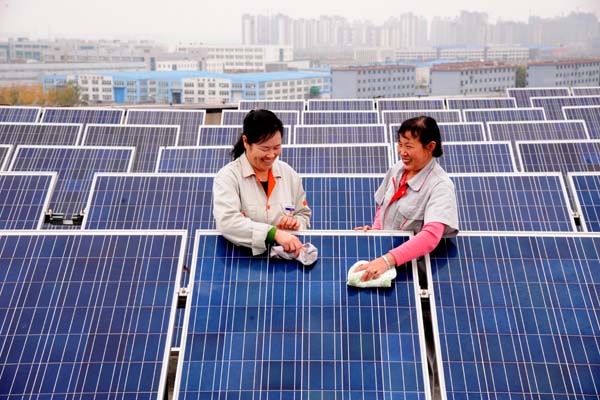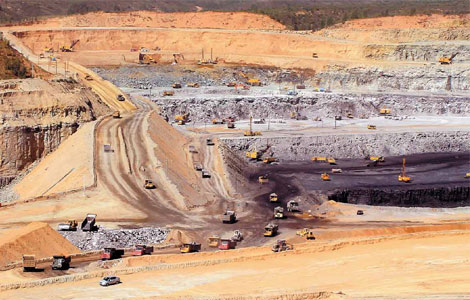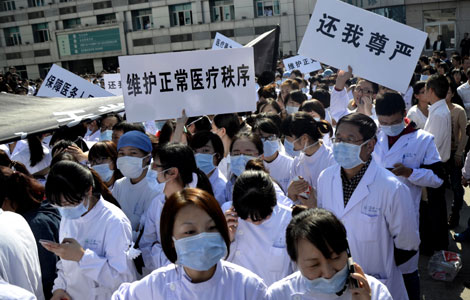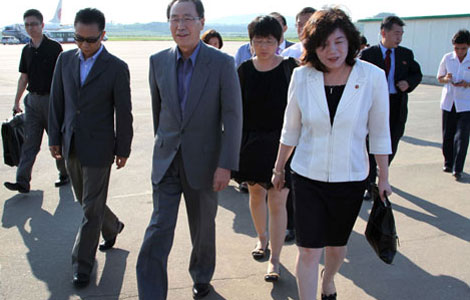Brighter outlook for solar power sector
Updated: 2013-11-07 09:58
By Xie Yu in Shanghai (China Daily)
|
||||||||
China plans to raise its whole-year target of installed solar capacity to 12 gigawatts in 2014, up by 20 percent from the original target, becoming the latest stimulus for the country's sluggish solar industry.
The new installation target for 2014 will include distributed solar capacity to 8 GW, and solar power stations with a capacity of 4 GW, according to a newly released document by the nation's energy authority.
"The specific installation number of solar capacity is a positive signal for solar companies, whether with regard to upstream silicon and panel manufacturers or to downstream solar project developers," said Eric Liu, deputy general manager of Upsolar, a photovoltaic module producer.
Solar companies experienced a moderate recovery in the third quarter. Statistics show 34 listed solar companies saw their aggregate net profit surge by 67 percent year-on-year in the third quarter of 2013. Five of nine returned to profit during the quarter.
|
 |
|
Statistics show 34 listed solar companies saw their aggregate net profit surge by 67 percent year-on-year in the third quarter of 2013. Five of nine returned to profit during the quarter. [Photo/China Daily] |
Ten percent of small and medium-sized companies have resumed production, according to Securities Daily.
Analysts say the recent recovery of solar manufacturers might have been triggered by short-term stimuli. It will take time to see if the rebound is sustainable.
Solar power station developers will get a payment of 1 yuan (16 US cents) per kilowatt-hour if their projects feed into the grid before Dec 31.
The payment might be brought down next year, so many developers have been rushing to finish the project, pushing up the sales of solar panels and modules in the third quarter, said Xu Chao, an energy analyst with Citi China Securities.
Although sales of modules were expanding in the past few months, almost no module manufacturers are increasing production, based on a cautious expectation of the future market, said Xue Jin, who operates a mid-sized module company in East China's Jiangsu province.
"Compared with big solar stations, distributed solar programs are mostly installed on roofs. They are flexible and more business efficient for developers," said Liu.
The sustainable development of China's solar industry should be backed by strong growth of distributed solar programs, which account for a very small proportion of the solar power generation in China now but have immense potential, he added.
The National Development and Reform Commission said in August that it would implement a new price structure that subsidizes about 0.42 yuan per kilowatt-hour for electricity produced by distributed solar PV projects.
The commission is working on specific regulations on managing distributed solar programs. Only programs registered and approved by local governments and within a capacity set by the authority will get the subsidy.
"Solar companies and investment companies are keenly following the progress of the specific policy, including details of the subsidy issue," Liu said.
China's goal of having 35 GW of installed solar power capacity by the end of 2015 is seven times the 5 GW it had installed at the end of 2012.
Most Viewed
Editor's Picks

|

|

|

|

|

|
Today's Top News
U. Michigan gets grant for China center
Lead author of Obamacare law blames govt for rollout
China's increasing role in global nuclear power
US companies in China feel squeeze
Panda cub drawing votes for her name
US, China team up for wildlife
E China still top draw for foreigners
Firm breaks ground for new Suzhou facility
US Weekly

|

|















